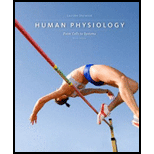
Human Physiology: From Cells to Systems (MindTap Course List)
9th Edition
ISBN: 9781285866932
Author: Lauralee Sherwood
Publisher: Cengage Learning
expand_more
expand_more
format_list_bulleted
Concept explainers
Question
Chapter 3.2, Problem 1CYU
Summary Introduction
To write:
Description of the extracellular matrix.
Introduction:
In the multicellular species like human beings, the plasma membrane not only acts as the outer covering of all the cells. It also takes part in cell-to-cell adhesions. These adhesions combine together the group of cells into tissues and parcel them further into organs. The cells arranged into suitable groupings are held in combination via three distinct means, that is, the extracellular matrix, cell-adhesion molecules, and the specialized cell junctions.
Expert Solution & Answer
Want to see the full answer?
Check out a sample textbook solution
Students have asked these similar questions
Standard Concentration (caffeine) mg/L
Absorbance Reading
10
0.322
20
0.697
40
1.535
60
2.520
80
3.100
Please draw in the missing answer, thank you
Please fill in all blank questions, Thank you
Chapter 3 Solutions
Human Physiology: From Cells to Systems (MindTap Course List)
Ch. 3.1 - Draw how phospholipid molecules align themselves...Ch. 3.1 - Prob. 2CYUCh. 3.1 - Prob. 3CYUCh. 3.2 - Prob. 1CYUCh. 3.2 - Prob. 2CYUCh. 3.2 - Prob. 3CYUCh. 3.3 - Prob. 1CYUCh. 3.3 - Distinguish between passive and active forces that...Ch. 3.4 - List the means of unassisted membrane transport.Ch. 3.4 - Prob. 2CYU
Ch. 3.4 - Prob. 3CYUCh. 3.5 - Draw a graph comparing simple diffusion down a...Ch. 3.5 - Describe what causes the carrier to change shape...Ch. 3.5 - Distinguish between symport and antiport.Ch. 3.6 - Prob. 1CYUCh. 3.6 - Describe the relative contributions of k+ and Na+...Ch. 3.6 - Prob. 3CYUCh. 3 - The nonpolar tails of the phospholipid molecules...Ch. 3 - Prob. 2RECh. 3 - Prob. 3RECh. 3 - At resting membrane potential, there is a slight...Ch. 3 - Using the answer code on the right, indicate which...Ch. 3 - Prob. 6RECh. 3 - Prob. 7RECh. 3 - Prob. 1UCCh. 3 - Prob. 2UCCh. 3 - What two properties of a particle influence...Ch. 3 - Prob. 4UCCh. 3 - Prob. 5UCCh. 3 - Prob. 6UCCh. 3 - Describe the contribution of each of the following...Ch. 3 - Using the Nernst equation, calculate the...Ch. 3 - One of the important uses of the Nernst equation...Ch. 3 - Using the Goldman-Hodgkin-Katz equation, determine...Ch. 3 - When William H. was helping victims after a...Ch. 3 - Which of the following methods of transport is...Ch. 3 - Assume that a membrane permeable to Na+ but not to...Ch. 3 - A solution may have the same osmolarity as normal...Ch. 3 - Prob. 4TAHLCh. 3 - Prob. 5TAHL
Knowledge Booster
Learn more about
Need a deep-dive on the concept behind this application? Look no further. Learn more about this topic, biology and related others by exploring similar questions and additional content below.Similar questions
- please fill in missing parts , thank youarrow_forwardplease draw in the answers, thank youarrow_forwarda. On this first grid, assume that the DNA and RNA templates are read left to right. DNA DNA mRNA codon tRNA anticodon polypeptide _strand strand C с A T G A U G C A TRP b. Now do this AGAIN assuming that the DNA and RNA templates are read right to left. DNA DNA strand strand C mRNA codon tRNA anticodon polypeptide 0 A T G A U G с A TRParrow_forward
- Please identify the curve shown below. What does this curve represent? Please identify A, B, C, D, and E (the orange oval). What is occurring in these regions?arrow_forwardPlease identify the test shown here. 1) What is the test? 2) What does the test indicate? How is it performed? What is CX? 3) Why might the test be performed in a clinical setting? GEN CZ CX CPZ PTZ CACarrow_forwardDetermine how much ATP would a cell produce when using fermentation of a 50 mM glucose solution?arrow_forward
- Determine how much ATP would a cell produce when using aerobic respiration of a 7 mM glucose solution?arrow_forwardDetermine how much ATP would a cell produce when using aerobic respiration to degrade one small protein molecule into 12 molecules of malic acid, how many ATP would that cell make? Malic acid is an intermediate in the Krebs cycle. Assume there is no other carbon source and no acetyl-CoA.arrow_forwardIdentify each of the major endocrine glandsarrow_forward
arrow_back_ios
SEE MORE QUESTIONS
arrow_forward_ios
Recommended textbooks for you
 Human Biology (MindTap Course List)BiologyISBN:9781305112100Author:Cecie Starr, Beverly McMillanPublisher:Cengage Learning
Human Biology (MindTap Course List)BiologyISBN:9781305112100Author:Cecie Starr, Beverly McMillanPublisher:Cengage Learning Human Physiology: From Cells to Systems (MindTap ...BiologyISBN:9781285866932Author:Lauralee SherwoodPublisher:Cengage Learning
Human Physiology: From Cells to Systems (MindTap ...BiologyISBN:9781285866932Author:Lauralee SherwoodPublisher:Cengage Learning Concepts of BiologyBiologyISBN:9781938168116Author:Samantha Fowler, Rebecca Roush, James WisePublisher:OpenStax College
Concepts of BiologyBiologyISBN:9781938168116Author:Samantha Fowler, Rebecca Roush, James WisePublisher:OpenStax College Human Heredity: Principles and Issues (MindTap Co...BiologyISBN:9781305251052Author:Michael CummingsPublisher:Cengage Learning
Human Heredity: Principles and Issues (MindTap Co...BiologyISBN:9781305251052Author:Michael CummingsPublisher:Cengage Learning Biology 2eBiologyISBN:9781947172517Author:Matthew Douglas, Jung Choi, Mary Ann ClarkPublisher:OpenStax
Biology 2eBiologyISBN:9781947172517Author:Matthew Douglas, Jung Choi, Mary Ann ClarkPublisher:OpenStax

Human Biology (MindTap Course List)
Biology
ISBN:9781305112100
Author:Cecie Starr, Beverly McMillan
Publisher:Cengage Learning

Human Physiology: From Cells to Systems (MindTap ...
Biology
ISBN:9781285866932
Author:Lauralee Sherwood
Publisher:Cengage Learning


Concepts of Biology
Biology
ISBN:9781938168116
Author:Samantha Fowler, Rebecca Roush, James Wise
Publisher:OpenStax College

Human Heredity: Principles and Issues (MindTap Co...
Biology
ISBN:9781305251052
Author:Michael Cummings
Publisher:Cengage Learning

Biology 2e
Biology
ISBN:9781947172517
Author:Matthew Douglas, Jung Choi, Mary Ann Clark
Publisher:OpenStax